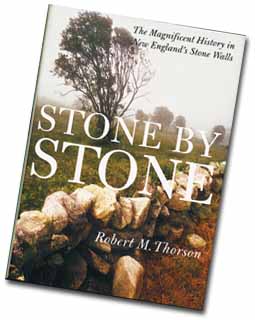|
This is an archived article.
For the latest news, go to the Advance
Homepage
For more archives, go to the Advance Archive/Search Page. |
|
|
Thorson's Book on Stone Walls Links
Natural Science, Human History By David Bauman
In a new book, Stone by Stone: The Magnificent History in New England's Stone Walls, published by Walker & Co. this month, Thorson introduces readers to what he calls "the signatures of rural New England." On Wednesday, September 18 at 4:30 p.m., the UConn Co-op will host a publication party for Thorson, who will be on hand to sign copies of his book and answer questions.
The stone walls of New England, says Thorson, especially the tumbledown, lichen-encrusted woodland walls built mostly between 1750 and 1850, have become part of the landscape. "Minnesota has its lakes, Arizona its canyons, Louisiana its bayous, Alaska its glaciers, and New England its stone walls," Thorson notes. "The landscape, then and now, would simply not be the same without them." He says the region's stone walls - there once may have been 250,000 miles of them, a distance greater than the U.S. coastline - link the natural history and the human history of New England. A stone pulled from an authentic New England wall "speaks all at once of ancient seas, glacial mud, and the tip of a scythe being broken during spring mowing a century ago," he writes. "By studying stone walls, you'll see the unending struggle of Yankee farmers — and also find signs of the melting and carving that have shaped the earth." Thorson begins the book with an exploration of natural science, pointing to bedrock geology, continental drift, ice ages, soils, and frost heave to explain how New England's rocks came to be where they are. He then moves to cultural factors, such as deforestation and farming, that allowed for the harvesting of the heavy stones. He argues that the walls were fundamentally neither fences that separated neighbors nor monuments to thriftiness and hard work. "The principal function of walls was to hold waste stone being generated by the agricultural enterprise," he says. "Stone walls were a necessary response to the environmental change from forest to farm." The ecological catastrophe of colonial farming, he says, caused frost-heaving and surface erosion on compacted soils during the peak of the Little Ice Age, and brought stones to the surface. "Colonial farmers knew practically nothing about natural processes," Thorson notes. "In fact, many farmers blamed the devil for the fieldstones of New England, which appeared as if by black magic in 17th and 18th-century fields." These fieldstones were carted away by hand or with the assistance of oxen and draft horses, and seldom further than necessary. Stacked upward, and organized slightly so that they would take up less space, the elongated piles of stones created permanent reminders and enduring symbols. "Each stone wall is an icon for a vanished agricultural civilization that flourished in farming communities during Colonial and early American times," Thorson says. "One glimpse of an abandoned stone wall in the woods conveys the human drama that took place in the once-continuous forest of New England, as the wilderness was tamed and replaced with family farms." Over the centuries, these abandoned walls have become an integral part of the woodland ecosystem and today have great ecological importance. They provide specialized drystone habitats for plants and creatures that would have trouble existing otherwise, he observes. They also regulate the flow of water and the movement of soil on the land. Yet permanent as New England's stone walls might appear, Thorson points out that they are ephemeral at the scale of earth history. Throughout the region, abandoned walls are disappearing through the slow process of weathering and the more dramatic process of collapse. All will eventually dissolve and wash to the sea, where they will be re-cycled back into rock or some other organic form.
|
 veryone who visits New England, will, unavoidably, meet
its stone walls. And Robert M. Thorson, a professor of geology and
geophysics at UConn, wants to help these two entities get better
acquainted.
veryone who visits New England, will, unavoidably, meet
its stone walls. And Robert M. Thorson, a professor of geology and
geophysics at UConn, wants to help these two entities get better
acquainted.
